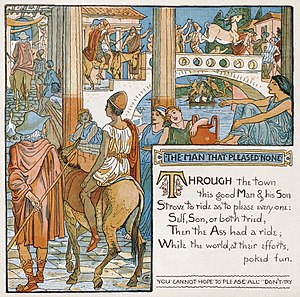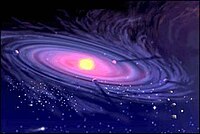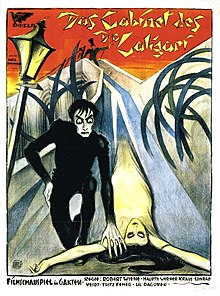Portal:Speculative fiction

Speculative fiction is an umbrella phrase encompassing the more fantastical fiction genres, specifically science fiction, fantasy, horror, supernatural fiction, superhero fiction, utopian and dystopian fiction, apocalyptic and post-apocalyptic fiction, and alternate history in literature as well as related static, motion, and virtual arts. It has been around since humans began to speak. The earliest forms of speculative fiction were likely mythological tales told around the campfire. Speculative fiction deals with the "What if?" scenarios imagined by dreamers and thinkers worldwide. Journeys to other worlds through the vast reaches of distant space; magical quests to free worlds enslaved by terrible beings; malevolent supernatural powers seeking to increase their spheres of influence across multiple dimensions and times; all of these fall into the realm of speculative fiction. Speculative fiction as a category ranges from ancient works to cutting edge, paradigm-changing, and neotraditional works of the 21st century. It can be recognized in works whose authors' intentions or the social contexts of the versions of stories they portrayed is now known. For example, Ancient Greek dramatists such as Euripides, whose play Medea (play) seemed to have offended Athenian audiences when he fictionally speculated that shamaness Medea killed her own children instead of their being killed by other Corinthians after her departure. The play Hippolytus, narratively introduced by Aphrodite, is suspected to have displeased contemporary audiences of the day because it portrayed Phaedra as too lusty. In historiography, what is now called speculative fiction has previously been termed "historical invention", "historical fiction," and other similar names. It is extensively noted in the literary criticism of the works of William Shakespeare when he co-locates Athenian Duke Theseus and Amazonian Queen Hippolyta, English fairy Puck, and Roman god Cupid all together in the fairyland of its Merovingian Germanic sovereign Oberon in A Midsummer Night's Dream. In mythography it has been termed "mythopoesis" or mythopoeia, "fictional speculation", the creative design and generation of lore, regarding such works as J. R. R. Tolkien's The Lord of the Rings. Such supernatural, alternate history, and sexuality themes continue in works produced within the modern speculative fiction genre. Jump to a specific section belowSelected profileCarolyn Janice Cherry (born September 1, 1942), better known by the pen name C. J. Cherryh, is an American writer of speculative fiction. She has written more than 80 books since the mid-1970s, including the Hugo Award–winning novels Downbelow Station (1981) and Cyteen (1988), both set in her Alliance–Union universe, and her Foreigner series. She is known for worldbuilding, depicting fictional realms with great realism supported by vast research in history, language, psychology, and archeology. Cherryh (pronounced "Cherry") appended a silent "h" to her real name because her first editor, Donald A. Wollheim, felt that "Cherry" sounded too much like a romance writer. She used only her initials, C. J., to disguise that she was female at a time when the majority of science fiction authors were male. (Full article...)Selected workThe Cabinet of Dr. Caligari (German: Das Cabinet des Dr. Caligari) is a 1920 German silent horror film directed by Robert Wiene and written by Hans Janowitz and Carl Mayer. Considered the quintessential work of German Expressionist cinema, it tells the story of an insane hypnotist (Werner Krauss) who uses a brainwashed somnambulist (Conrad Veidt) to commit murders. The film features a dark, twisted visual style, with sharp-pointed forms, oblique, curving lines, structures and landscapes that lean and twist in unusual angles, and shadows and streaks of light painted directly onto the sets. The script was inspired by various experiences from the lives of Janowitz and Mayer, both pacifists who were left distrustful of authority after their experiences with the military during World War I. The film makes use of a frame story, with a prologue and epilogue combined with a twist ending. Janowitz said this device was forced upon the writers against their will. The film's design was handled by Hermann Warm, Walter Reimann and Walter Röhrig, who recommended a fantastic, graphic style over a naturalistic one. (Full article...) Selected quote
—Harry Harrison (b.1925), "The Time of the Other: Alternate History and the Conquest of America" in Strange Horizons (2002). Selected picture "The Man That Pleased None", from Walter Crane's 1887 illustrated book The Baby's Own Aesop, a collection of Aesop's Fables retold in limerick format. Aesop lived in Ancient Greece between 620 and 560 BCE, and his fables are some of the most well known in the world, remaining a popular choice for moral education of children today. Crane, a member of the Arts and Crafts movement, popularised the child-in-the-garden motifs that would characterise many nursery rhymes and children's stories for decades to come. (POTD) Did you know...
Upcoming conventionsApril:
May:
Dates can usually be found on the article page. See also these convention lists: anime, comic book, furry, gaming, multigenre, and science fiction. Selected article The blue men of the Minch, also known as storm kelpies (Scottish Gaelic: na fir ghorma Scottish Gaelic pronunciation: [nə fiɾʲ ˈɣɔɾɔmə]), are mythological creatures inhabiting the stretch of water between the northern Outer Hebrides and mainland Scotland, looking for sailors to drown and stricken boats to sink. They appear to be localised to the Minch and surrounding areas to the north and as far east as Wick, unknown in other parts of Scotland and without counterparts in the rest of the world. Apart from their blue colour, the mythical creatures look much like humans, and are about the same size. They have the power to create storms, but when the weather is fine they float sleeping on or just below the surface of the water. The blue men swim with their torsos raised out of the sea, twisting and diving as porpoises do. They are able to speak, and when a group approaches a ship its chief may shout two lines of poetry to the master of the vessel and challenge him to complete the verse. If the skipper fails in that task then the blue men will attempt to capsize his ship. (Full article...)On this day...Film releases
Births
Deaths
Anniversaries and events
Possible futuresPossible events in the future as suggested by science fiction:
Things you can do...Here are ideas for how you can help improve the coverage of speculative fiction topics on Wikipedia: Join a WikiProject or task force:
Start a requested article:
Expand a stub: Expand a new article:
Note: If no articles are shown below, please work on those found in the Archive. This list was generated from these rules. Questions and feedback are always welcome! The search is being run daily with the most recent ~14 days of results. Note: Some articles may not be relevant to this project. Rules | Match log | Results page (for watching) | Last updated: 2024-04-22 22:21 (UTC) Note: The list display can now be customized by each user. See List display personalization for details.
Recognized contentFeatured articles are considered to be the best on Wikipedia, as determined by Wikipedia's editors, and Good articles are those which are considered to be of good quality but which are not yet featured article quality. If you see one that should be listed here, please add it or post on the talk page and let us know so we can add it for you. Speculative fiction topicsCreators: Artists (list) · Authors (by nationality) · Editors Fantasy
Creators: Artists · Authors Horror
Creators: Artists · Authors SubcategoriesRelated portalsWikimediaThe following Wikimedia Foundation sister projects provide more on this subject:
Associated content
Science fiction The following Wikimedia Foundation sister projects provide more on this subject:
Fantasy The following Wikimedia Foundation sister projects provide more on this subject:
Horror The following Wikimedia Foundation sister projects provide more on this subject:
Portal directory |



























